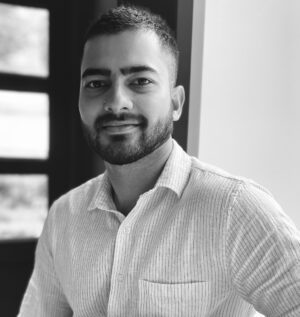
Vishal Khandelwal
Growing up in Kolkata, Vishal Khandelwal – now an Assistant Professor of History of Art and Architecture in Harvard’s Department of History of Art + Architecture – was first introduced to the art history field right before he left India to attend DePauw University in Indiana. An art historian friend from Kolkata encouraged him to take undergraduate classes in the field, and this advice proved to be a turning point in Khandelwal’s academic journey.
“When I took classes at DePauw, I found the questions my professors asked deeply compelling,” Khandelwal recalls. “We were analyzing art and architectural works in all their complexity, and thinking critically about the people behind them—those that created, viewed, or used them. These classes pushed me to reflect on how individuals interact with one another, how we perceive ourselves in relation to others, and how art and architecture serve as powerful vehicles for exploring these broader, human questions.”
Khandelwal’s coursework introduced him to two pivotal mentors—a medieval art historian and a modern art historian—who encouraged him to blend his burgeoning interest in art and architectural history with research on South Asia. After he studied abroad in Rome and later in Oxford, his experiences helped him shape a research topic that would form the foundation of his Ph.D. applications.
After enrolling in a Ph.D. program at the University of Michigan, Khandelwal took courses not only in art and architectural history, but also in anthropology and history. However, it was his fieldwork that truly solidified his focus. Through grant funding from the university and from external organizations, Khandelwal was able to travel to the National Institute of Design (NID) in Ahmedabad, India, to explore their archives – a project that evolved into his dissertation and now his current book manuscript, tentatively titled Crafted Visions: India and the Values of Design, 1955-1985.
“It was a privilege to have the funding and time to travel to sites and archives because with research in art and architectural history, we have to travel to things; things don’t generally travel to us!” says Khandelwal. “And when I went off into the field, I found this amazing trove of materials on postcolonial architecture and design education that few had looked at before.”
When I went off into the field, I found this amazing trove of materials on postcolonial architecture and design education that few had looked at before.
In the NID official archive, Khandelwal began unraveling a history of the academy in relation to similar educational cultures in other parts of the world. He tracked specific practitioners who taught visual communication, textile design, architecture, and product design at the NID between 1955 and 1985, and who were all concerned in some way or the other about crafts objects and crafts-related livelihoods from within the capacious field of design studies. And he worked with families of artists, designers, architects, and critics to source archival materials and original design and art objects that became the bulwark of his research. Khandelwal says he connected families with institutions like the Asia Art Archive in India to help in digitization efforts, and is encouraged by the fact that more families of designers, architects, and artists have over the years been coming forward with archival materials to add to various institutional collections.


Photos of the NID campus in Ahmedabad, taken by Prof. Khandelwal during fieldwork.
As Khandelwal finalizes his manuscript for publication, he is also embarking on a new project that explores the intersections of architecture and textile art during the modern period. “The project aims to understand what happens when we think about buildings through a medium that is flexible and malleable – qualities often seen as the opposite of traditional architecture,” Khandelwal explains. “During the twentieth century—which is my primary focus—but even before that, textile art in South Asia and elsewhere often came in serious conversation with parallel developments in architecture.” Khandelwal’s research investigates how crafts and textiles contributed to the shift away from the high modernism of the 1950s and toward the 1970s, when architects began embracing regionalist idioms within their practices. Some of these ideas about the historical relationship between architecture and textiles were put to test through a seminar titled “Architectures of Cloth,” co-designed and co-taught in Spring 2024 by Khandelwal and his colleague Maria Gough, the Joseph Pulitzer, Jr. Professor of Modern Art at Harvard.
“Looking at or experiencing a building or space in person adds new dimensions to your teaching and research, and then I particularly enjoy the work of cross-checking materials obtained from different archives,” explains Khandelwal. “There can be many sides to a picture, and it’s fun to lay out complex problems for the reader to grapple with, and through the archival or material evidence, when available. I really like this task of the historian.”
Written by Kellie Nault, a Writer/Editor with the Mittal Institute.
☆ The views represented herein are those of the interview subject and do not necessarily reflect the views of the Mittal Institute, its staff, or its steering committee.
